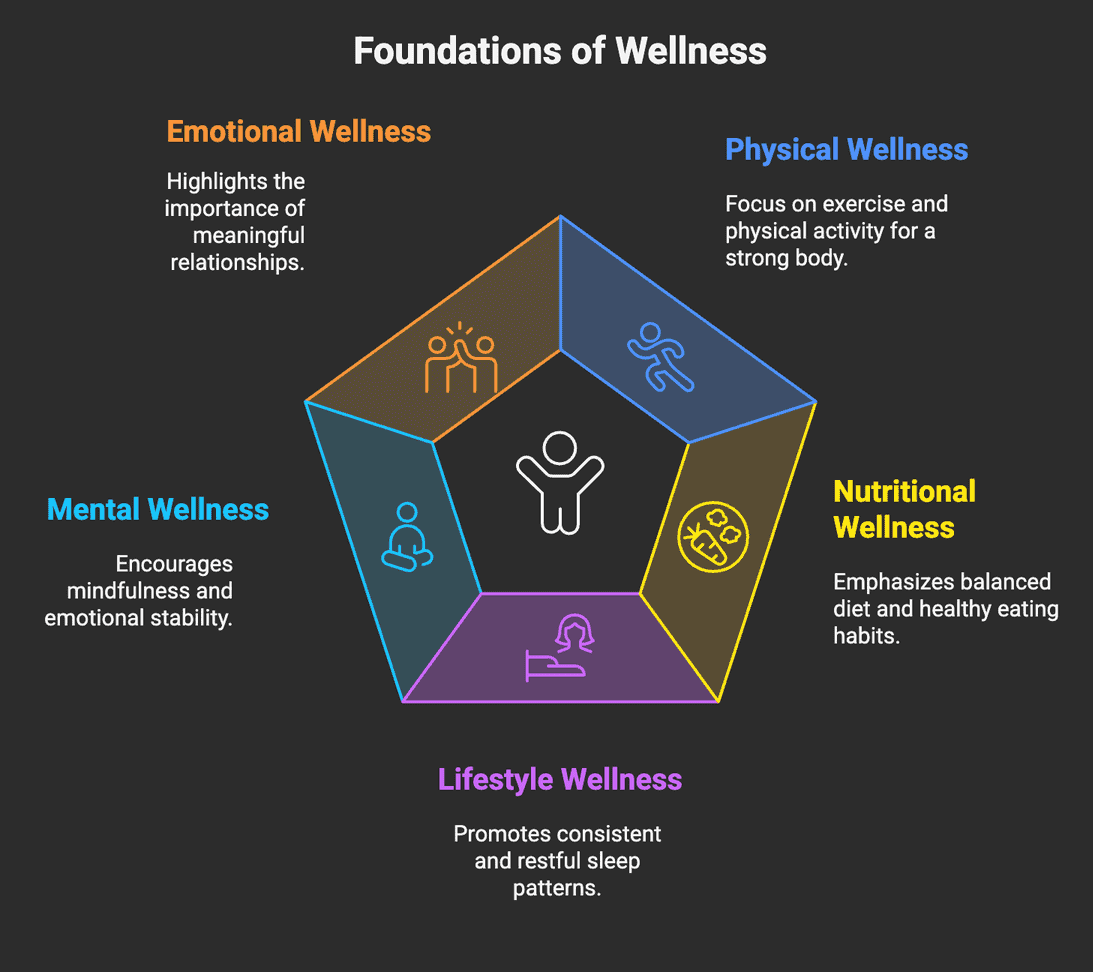Introduction:
What if I said real wellness isn’t about perfecting any one aspect of your health—it’s about maintaining five interdependent pillars that each contribute to your overall well-being?
The majority of people think of health in the same way they think of a yo-yo diet—focusing hard on three weeks of hitting the gym, then switching to nutritional fixatives or new bedtimes, only to be overwhelmed and back where they began.
But what I’ve learned after studying thousands of successful wellness transformations is this: People who succeed at lasting health don’t chase quick fixes. They create a solid base in five key areas that add up to the legs of a sturdy table.

Welcome to the Fivenurture way of life—where health is sustainable, fun, & life-changing.
Why Most Health and Wellness Strategies Fail:
But before we get into the five pillars, let’s chat about why traditional health advice often leaves you feeling frustrated:
- Single-focus obsession: putting all your effort on one point, the exercise or the diet.
- All-or-nothing mentality: Thinking you have to be perfect in every aspect of your life right away.
- Ignoring interconnections: There is no knowledge of how sleep relates to nutrition or how stress relates to fitness.
- Quick-fix expectations: Expecting instant outcomes rather than nurturing lifelong habits
Pillar 1: Physical Wellness—Your Body’s Foundation

What It Includes:
- Regular movement and exercise
- Strength and flexibility training
- Cardiovascular health
- Energy levels and vitality
- Recovery and rest
Why It Matters: A fit body is the vehicle that carries you through life. When it is strong, energetic, and well-maintained, everything in life becomes easier. A study from Harvard Medical School has shown that regular physical exercise can reduce the risk of chronic diseases by up to 50% and significantly improve mental health.
The Fivenurture Approach to Physical Wellness:
Start Small, Build Strong
Instead of beginning intensive training regimens right away, begin with
- Daily movement: 10-15 minutes’ walk, stretching, or easy exercises.
- Strength basics: Try bodyweight exercises twice a week.
- Flexibility focus: 5-10 minutes of stretching before bedtime.
- Energy awareness: Notice which activities make you feel alive or energized and which ones just drain your energy.
Your Physical Wellness Action Plan
- Weeks 1-2: Set up a 10-minute morning exercise routine.
- Weeks 3-4: Add 2 sessions of basic strength training (even if it’s for only 15 minutes).
- Month 2: Begin to increase the intensity or duration of your exercise, based on how you’re feeling.
- Month 3: Find things you like to do, like dancing, hiking, playing sports, or doing yoga.
Success Indicator
- In the mornings, you wake up with more energy.
- The tasks of daily living have become easier for you.
- You sleep better after working out.
- You start to look forward to movement instead of dreading it.
Pillar 2: Nutritional Wellness—Fuel That Serves You

What It Includes:
- Balanced, nourishing meals
- Proper hydration
- Understanding your body’s unique needs
- Healthy relationship with food
- Energy-sustaining eating patterns
Why It Matters: What you eat is a signal to your body. Each meal sends your body signals to either support or work against your health. But nutritional wellness is not about eating perfectly—it’s about making choices that make you feel good, have sustainable energy, and support your other wellness goals.
The Fivenurture Approach to Nutritional Wellness:
Progress Over Perfection
Concentrate more on what you’re including rather than what you’re excluding
- Hydration is key: let’s start every day by drinking 16 oz of water.
- Protein Priority: Include a source of protein with every meal to maintain consistent energy levels.
- Mindful eating: Eat without distractions, paying attention to how foods make you feel.
Your Nutritional Wellness Action Plan
- Weeks 1-2: Focus on hydration and adding one extra vegetable daily.
- Weeks 3-4: Plan and prepare one healthy meal per day.
- Month 2: Try new healthy foods and recipes.
- Month 3: Work on intuitive eating skills and food freedom.
Success Indicators:
- Consistent energy all day long.
- Reduced Cravings for Junk Foods.
- Improved digestion and gut health.
- A healthy relationship with food and eating.
Pillar 3: Mental Wellness—Your Cognitive Command Center

What It Includes:
- Stress management and resilience
- Cognitive function and mental clarity
- Learning and personal growth
- Productivity and focus
- Emotional regulation
Why It Matters: Your mental health is a keystone of all the rest. You can eat all the right nutrition and exercise all you want, but if you’re chronically stressed, you won’t be getting or sustaining the full benefit, while mental clarity helps you make better choices in all areas of your life. According to the American Psychological Association, adequate stress management can also make us healthier, happier, and more satisfied with life.
The Fivenurture Approach to Mental Wellness:
Building Mental Resilience
Create daily habits that will improve your mental fitness
- Mindfulness moments: 5 minutes of deep breathing or meditation
- Stress awareness: Recognize what causes you stress and what your warning signs are.
- Learning habits: Read, listen to a podcast, or learn something new every day.
- Taking breaks: Develop regular periods of no screen experience or stimulation.
Your Mental Wellness Action Plan
- Weeks 1-2: 5 minutes of mindfulness (breathing, meditation, gratitude) every day.
- Weeks 3-4: Identify and address your top 2 stress triggers.
- Month 2: Develop a consistent learning or creative hobby.
- Month 3: Build advanced stress management and emotional regulation skills.
Success Indicators
- In stressful times, you remain calm and composed.
- Increased focus and attentiveness
- Enhanced ability to make choices
- Greater creativity and problem-solving skills
Pillar 4: Emotional Wellness—Your Heart’s Health

What It Includes:
- Healthy relationships and social ties
- Self-compassion and self-awareness
- Emotional intelligence and communication
- Joy, gratitude, and positive emotions
- Boundary setting and self-care
Why It Matters: Emotional wellness is usually the most neglected pillar, but it’s essential for enduring health. Harvard’s Grant Study—the longest-running happiness study—reveals that robust relationships and solid emotional health are the greatest indicators of life satisfaction and lifespan.
The Fivenurture Approach to Emotional Wellness:
Nurturing Your Emotional Garden
Cultivate practices that support emotional growth
- Daily gratitude: List 3 things every single day that you are grateful for.
- Relationship investment: Keep doing regular relationship “check-ins” with people who matter to you.
- Boundary practice: Get into the habit of saying no to protect your energy and well-being.
- Self-compassion: Adjust your attitude towards yourself as though you were your own best friend.
Your Emotional Wellness Action Plan
- Weeks 1-2: Start a daily gratitude practice and call up someone you care about.
- Week 3: Practice enforcing one small boundary and see how it feels.
- Month 2: Practice your communication skills and conflict-solving.
- Month 3 and beyond: Develop your emotional intelligence and empathy skills.
Success Indicators:
- You will develop stronger and valuable relations.
- Better communication and less conflict.
- Enhanced self and emotional self-control (self-awareness and emotional restraint).
- More joy and fulfillment in daily life.
Pillar 5: Lifestyle Wellness—Your Environment and Habits

What It Includes:
- Sleep quality and recovery
- Work-life balance and time management
- Living environment and organization
- Financial wellness and security
- Purpose and meaning in daily life
Why It Matters: Almost everything else you do to be healthy either happens in the environment created by your lifestyle or depends on it. Ideal nutrition can be ruined by poor sleep. The stress levels are elevated, and healthy decisions are more difficult in a chaotic environment. Health is afflicted in all areas when it comes to financial pressure.
Creating Your Wellness Environment
Design a life that makes healthy choices easier
- Sleep sanctuary: Make your bedroom into a place for quality rest.
- Morning and evening routines: Start and finish each day by focusing on wellness.
- Organized spaces: Establish environments that support your goals and relieve stress.
- Time boundaries: Protect time for the activities that matter most to you
Success Indicators:
- Quality and regular sleep (about 7-9 hours a day).
- Less stress and more peace in everyday surroundings.
- Better work-life integration.
- Feeling aligned with your values and purpose.
How the Five Pillars Work Together:
What makes the five pillars system special is not how we perfect each area, but rather understanding how they support one another and make it possible to improve in all areas.
- Physical + Nutritional: Exercise improves how your body uses nutrients; good nutrition fuels better workouts.
- Mental + Emotional: When you manage stress well, your relationships flourish—and those strong relationships help you handle stress even better.
- Lifestyle + All Others: Good sleep and organized environments make it easier to exercise, eat well, manage stress, and maintain relationships.
- Benefit of several actions: When you improve one pillar, it makes the others easier to maintain, and vice versa.
Your 30-Day Fivenurture Challenge
Ready to experience the power of the five pillars? Here’s your gentle introduction:
Week 1: Foundation
- Choose one small action from each pillar:
- Physical: Walk for 10 minutes daily.
- Nutritional: Drink water first thing in the morning.
- Mental: Do 5 min of deep breathing.
- Emotional: Start a daily gratitude practice.
- Lifestyle: Have a regular bedtime.
Week 2: Building
- Add one more action to each pillar:
- Physical: Incorporate 2 strength exercises.
- Nutritional: Include protein food in every meal.
- Mental: 10 minutes to learn something new.
- Emotional: Talk to someone you care about.
- Lifestyle: Organize one of your living space.
Week 3: Expanding
- Increase intensity or duration:
- Physical: Increase the daily walking time.
- Nutritional: Try a new healthy recipe every day.
- Mental: Practice mindfulness during daily activities
- Emotional: Set a gentle boundary
- Lifestyle: Have a morning Routine to set the Tone of Your Day.
Week 4: Integration
- Focus on how the pillars support each other.
- Notice how better sleep improves your workouts.
- See how Good nutrition keeps your mind stable.
- Observe how regular exercise can relieve stress.
- Appreciate how the organization reduces decision fatigue.
Common Mistakes to Avoid:
- ❌ It’s a mistake to attempt to master all of the Five Pillars at once. ✅ Start with a small step and gradually build it up.
- ❌ Judging yourself for not being perfect. ✅ Celebrate progress and learn from failure.
- ❌ We often compare our trials with those of others.✅ Pay attention to your specific needs and circumstances.
- ❌ Don’t give up everything because of one mistake. ✅ Return to your work without self-judgment.